HDTV Antennas
In order to assist translator system viewers in pulling in the best possible signal, what follows is a list of tips for installing an antenna or “tuning up” an existing antenna. The channels broadcast by West Lane Translator are all in the UHF band (specifically UHF channels 24, 26, 28, 32 and 35) so make sure that your antenna is designed to receive UHF. A UHF-only antenna is ideal. A combined VHF/UHF antenna is also suitable although the elements of it that receive VHF will be of no use.
Indoor Antennas
In most cases, a simple indoor, top-of-set receiving antenna should be adequate to pull in enough signal to provide satisfactory operation. Such antennas are neither expensive nor are they difficult to install.
Indoor antennas come in a variety of sizes and shapes, from the familiar “rabbit ears with a loop” to futuristic panel antennas that look more like a radar array than a set-top antenna.
Examples of Indoor UHF Antennas
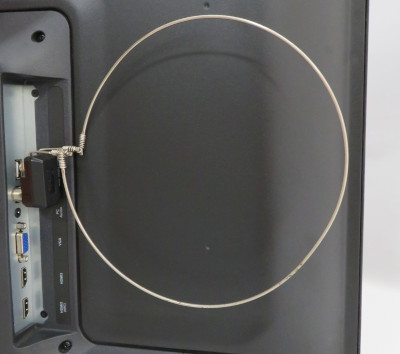
UHF loop antenna on TV’s antenna input
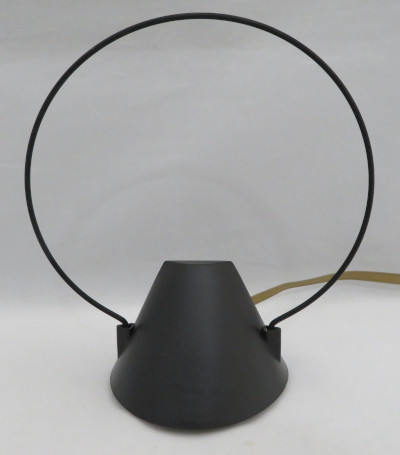
Freestanding UHF loop antenna

UHF flat antenna
Your antenna choice may come down to a matter of interior decor rather than antenna performance if you have enough signal strength. In general, a flat face of the antenna should point towards the translator tower.
Be sure that any indoor antenna you use or purchase has a built-in UHF “loop” antenna. The telescoping rod type antennas are meant for VHF reception only, and will be of no benefit in receiving WLT translator signals.
Many indoor antennas are available with a built-in preamplifier to boost weak signals. While a preamp may improve your reception, it is also possible that it may degrade antenna performance. As a rule, try to select an antenna which will supply your receiver with an adequate signal without the use of an amplifier. If using an amplifier gives you good results, that’s fine, but usually, if you don’t have enough signal to make an indoor antenna work, you should then step up to an outdoor antenna.
Outdoor Antennas
If you live on the fringes of the signal area, or have obstructions such as trees, hills, or buildings between your antenna and the WLT transmitter site on Glenada Hill south of town, you may benefit from the use of a high-gain outdoor antenna. The following section will assist you in choosing and installing an outdoor antenna:
Make sure you have the right antenna. All of our translators operate on the UHF portion of the band, so that is the correct type of antenna to choose. The older types of UHF antennas that were designed for channels 70 to 83 do not work well on channels 14 through 60, which is the portion of the band we are interested in receiving. The “bowtie” type antenna is a favorite and performs very well on UHF channels. There are other types that work quite well also.
Examples of Outdoor UHF Antennas
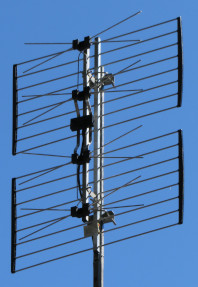
UHF Bowtie antenna
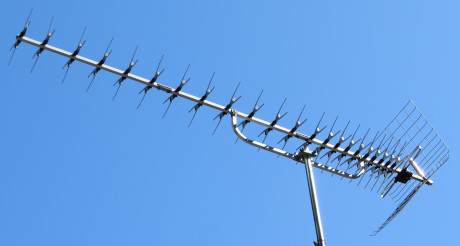
UHF Yagi antenna
Bowtie antennas should be aimed with the “bowties” facing the translator tower. Yagi antennas should be aimed with the smaller end pointing towards the translator tower.
Install your antenna “in the clear” above trees, buildings, or other obstructions (if possible). Be sure it is in a safe area, away from any and all power lines. If this results in a down-lead (the wire from the antenna to the TV set) that is over about 50 feet long, consider installing a UHF preamplifier or “booster”. With a good preamp you can use enough down-lead cable to position your antenna at the most ideal location.
Have someone move your antenna vertically, either up or down on its mount while you watch your set or the signal meter that you can checkout from the library. Switch among the various channels with the antenna at different heights instead of viewing just one channel. Locate the antenna position which results in the best overall reception on all the channels. This may be necessary even if you have a clear unobstructed view of the translator tower. Signal reflections from the ground in front of your receiving antenna or other nearby objects such as buildings usually cause “hot spots” and “cold spots”. Moving your antenna, especially moving it vertically, even a foot or two can have a dramatic effect on signal strength.
Antenna Cables
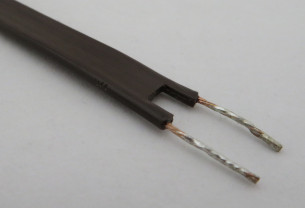
Twin Lead Cable
If your down-lead is of the twin-lead type (a brown or black colored cable with two wires embedded along the edges), replace it with coax. You will encounter too many problems dealing with this type of antenna lead-in wire than is worth the effort to keep it.
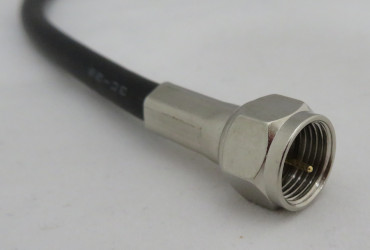
Coax with F Connector
In many ways, a coaxial cable (type RG-6 is best) down-lead is easier to install as it can be run in any manner whatsoever. The wave or television signal energy is totally contained inside the cable and the only way to hamper or degrade the signal it is carrying to your TV set is to squash the whole cable. However, matching transformers may be needed at the antenna to go from the two screw terminals to the coaxial cable “type F” connector. These matching transformers must be capable of operating efficiently at UHF frequencies and must be weatherproof types. Ask your dealer for the proper ones.
Most TV sets made nowadays have the coaxial type F connector for input, so these sets are ready for the coaxial down-lead cable.
Amplifiers
A TV antenna amplifier may be used to boost the signal received from your antenna. If your antenna is not receiving a good signal, boosting the poor signal it receives with an amplifier will not make it better. Amplifiers are used instead to boost a good signal from the antenna to overcome signal loss when you have a long length of cable or when the signal is split to multiple televisions.
More Information and Antenna Resources
Each of West Lane Translator’s UHF HDTV translators operates at an effective radiated power of 2,500 watts. The transmitting equipment is only half of the total system, however. The other half is your receiving equipment which, like the translator, it must be kept in top condition if the maximum potential of the system is to be realized.
These links to external sites will allow you to research antenna performance and learn more about what type of antenna will best suit your needs.
| Antenna Web | Geographical antenna selector |
| TV Fool | Resources for over-the-air (OTA) broadcast services (TV, FM, and others) |